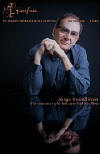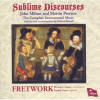Texte paru dans: / Appeared in:

Fanfare Magazine: 35:5 (05-06/2012)
Pour
s'abonner / Subscription information
Les abonnés à Fanfare Magazine ont accès aux archives du
magazine sur internet.
Subscribers to Fanfare Magazine have access to the archives of the magazine
on the net.
Regent Records
REGCD341

0802561034124 (IDV24)
Consultez toutes les évaluations recensées pour ce cd
~~~~ Reach all the evaluations located for this CD
The sacred music of Jacobean composers Martin Peerson (c.1572–1651) and John Milton Sr. (1562–1647) was effectively paired on Regent Records’ 2008 release A Candle to the Glorious Sun, sung by the Chapel Choir of Selwyn College, Cambridge, under Sarah MacDonald. Regent’s 2011 release of the two composers’ complete instrumental music is a worthy companion, providing a welcome addition to the available recordings of this fine repertoire.
Milton was a successful scrivener and amateur composer and poet (as well as father of the more famous Milton the poet). Milton wrote his viol consort music for domestic performance by musicians seated around a table. His writing is very vocal in nature, and the members of Fretwork give it a fine and generous reading, the rhetoric of the music always at the fore. Particularly fine is Milton’s six-part In Nomine If That a Sinner’s Sighs, in which the composer sets the borrowed plainchant fragment to an English text, most probably by the composer himself. Countertenor Michael Chance sings the cantus firmus, his ethereal voice sounding particularly distant, even spectral, in relation to the close and intimate sound of the viols.
Martin Peerson’s works are slightly more familiar to fans of Elizabethan and Jacobean music, most probably due to the four pieces that were included in the Fitzwilliam Virginal Book. Sophie Yates gives them an elegant and spirited reading, with bracingly crisp articulation never getting in the way of the phrasing and a keen sense of the instrument’s resonance. Yates plays Peerson’s best-known keyboard piece, an alman, with a delightful lightness of touch and breezy spirit. In The Fall of the Leafe, she balances percussive power with an impeccable sense of timing and articulation—the perfect antidote to too many dull and note-busy recordings of this repertoire.
Peerson’s viol music makes more demands on its players than does Milton’s, and adheres a bit less strictly to its vocal models. The extreme (for its time) harmonic language of his fantasia Attendite, popule meus showcases Fretwork’s near-flawless intonation and the group’s superb ensemble playing, from each imitative entrance to every calm and collected final cadence. Listening to the ebb and flow of the consort’s dynamics is hypnotic—the ear is drawn in to every nuance and awaits the next ensemble crescendo with bated breath.
For the recording, the individual players sit in an open circle in mixed formation, much like they would have done around a table when this music was new. The result is a wide soundstage that effectively transmits the music’s intricate polyphony. Moreover, the recording preserves the subtle color balance of the viol consort—neither string nor wood predominates. My only qualm with the album is the relative position on the soundstage of consort versus solo virginal. After four tracks of viol music, the percussive entrance of the keyboard is more than a bit jarring.
Cliquez l'un ou l'autre
bouton pour découvrir bien d'autres critiques de CD
Click either button for many other reviews


